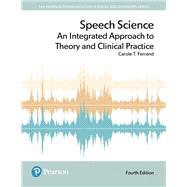Note: This is the bound book only and does not include access to the Enhanced Pearson eText. To order the Enhanced Pearson eText packaged with a bound book, use ISBN 0134675444.
Speech Science: An Integrated Approach to Theory and Clinical Practice, 4th Edition focuses on the relationship between the scientific study of speech production and perception and the application of the material to the effective evaluation and treatment of communication disorders. Theoretical material is presented first, followed by clinical application chapters highlighting specific disorders. The organization of chapters in the new edition now more closely follows the speech subsystems approach, beginning with basic acoustics, and moving on to the respiratory system, phonatory system, articulatory/resonatory system, auditory system, and nervous system. As in previous editions, the book concludes with information on classic and current models and theories of speech production and perception. New and revised full color illustrations and larger spectrograms supplement the concepts presented by clearly depicting scientific and anatomical material and ensuring understanding of the links between the underlying science and human communicative behavior.
Improve mastery and retention with the Enhanced Pearson eText*
The Enhanced Pearson eText provides a rich, interactive learning environment designed to improve student mastery of content. The Enhanced Pearson eText is:
- Engaging. The new interactive, multimedia learning features were developed by the authors and other subject-matter experts to deepen and enrich the learning experience.
- Convenient. Enjoy instant online access from your computer or download the Pearson eText App to read on or offline on your iPad® and Android® tablet.*
- Affordable. Experience the advantages of the Enhanced Pearson eText along with all the benefits of print for 40% to 50% less than a print bound book.
*The Enhanced eText features are only available in the Pearson eText format. They are not available in third-party eTexts or downloads.
*The Pearson eText App is available on Google Play and in the App Store. It requires Android OS 3.1-4, a 7” or 10”










